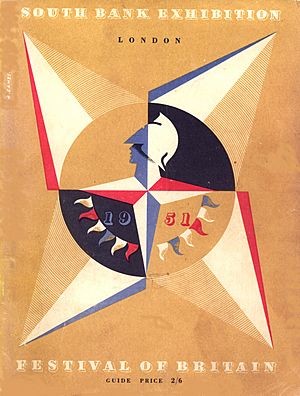Festival Star facts for kids

The Festival Star was a special symbol created by Abram Games for the 1951 Festival of Britain. Games was one of 12 artists asked to design something for the festival. He won the competition in 1948. The organizers wanted a design that showed a "summer of gaiety and good looks."
What the Festival Star Looks Like
The logo, which Games called an emblem, uses the traditional red, white, and blue colors of the Union Flag (the British flag). The main part of the design shows the head of Britannia, a symbol of Britain, wearing a helmet. Her head is placed at the "north" point of a four-pointed compass rose.
Games added a row of bunting flags to his first idea to make it look more festive. The compass points are partly colored and partly white. The "east" and "west" points are red and white. The "north" and "south" points, including Britannia's head, are blue and white.
The numbers "19" in blue and "51" in red appear in the bottom left and right sections. Below the "south" compass point, there are quarter-circles of bunting connecting to the "east" and "west" points. There are six flags on each side of the "south" point. A pattern of four flags (white, red, white, blue) repeats three times.
Where You Could See the Logo
This famous logo appeared on many official items and souvenirs. You could find it on things like beer mats, paper napkins, and even plastic cocktail sticks. It was also used on village signs put up in every village in Bedfordshire by the local council.
Games also designed a poster for London Transport based on his logo. This poster showed the flat compass rose as a 3D structure, like a signpost. Britannia's head was replaced with the London Transport roundel (their circular logo). Even today, you can still see the logo used in advertisements for the South Bank area of London.
A Giant Festival Star Hanging in London
A huge, 40-foot (12-meter) three-dimensional Festival Star was also made. It hung over Northumberland Street in London, becoming a main attraction for the celebrations. This four-pointed star was built by Essex Aero using 763 square feet (71 square meters) of light magnesium metal. Even though it was so big, it weighed only 1,790 pounds (812 kilograms).

